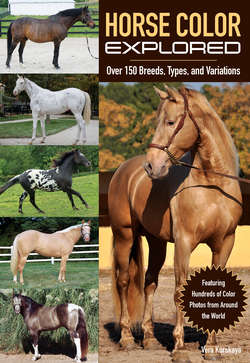Читать книгу Horse Economics - Vera Kurskaya - Страница 38
На сайте Литреса книга снята с продажи.
COLORS DETERMINED BY THE SILVER GENE
ОглавлениеThe colors of this group (Z) were defined rather recently, at the beginning of the twenty-first century. Understanding the true distribution of these colors is difficult because they are rare, although apparently this dilution is present in quite a few different breeds. Color identification in doubtful cases should be guided in part by whether or not a color has shown to be present in a specific breed. Therefore, I feel it necessary to provide a list of breeds in which the Silver gene occurs at the beginning of our discussion. The list includes the: Rocky Mountain Horse, Kentucky Mountain Saddle Horse, Quarter Horse, American Miniature Horse, Morgan, Appaloosa, Missouri Foxtrotter, Virginia Highlander, Paint Horse, Tennessee Walker, Mustang (particularly those found in Oregon, Nevada, and California), Icelandic Horse, Northlands Pony, Australian Pony, Connemara Pony, Shetland Pony, Swedish Warmblood, Finnish Warmblood, Dutch Warmblood, Gypsy Horse, Welsh Pony, Ardennes, Soviet Heavy Draft, and the Byelorussian Harness Horse. It has been determined by DNA analysis that carriers of the Silver gene were also found in the Haflinger breed, but there isn’t a visible color effect because this breed occurs only in the red (chestnut) color. Remember that Silver Dilute horses and dark flaxen chestnuts can look similar.
Silver color displays the following characteristics:
Many silver horses show a characteristic marble pattern on the legs called webbing. This has a “rusty” appearance or looks like whitish, irregular, elongated streaks with sharp boundaries (Photos 45–47).
Ashy or black hair in the mane and tail are found frequently (Photo 48). Silver horses can have yellowish guard hair of a dim, rather dirty shade, but not red or reddish, which would be typical for flaxen chestnuts.
Striped hooves are found in some silver horses, but they are not always present (see Photo 46). They differ from the striped hooves of appaloosa-spotted horses (see p. 55), because the stripes in silver horses are not black, but dark gray, and do not have sharp borders. Often their stripes are wedge-shaped. Striped hooves can be observed in foals, although in the process of the horse maturing, they may disappear.
Pronounced seasonal dapples are observed in some silver horses (silver dapple—see p. 28), appearing in summer and vanishing in winter (Photo 49).
Light eyelashes (white or yellowish), while not present on all silver horses, are a reliable characteristic seen on most (Photo 50).
